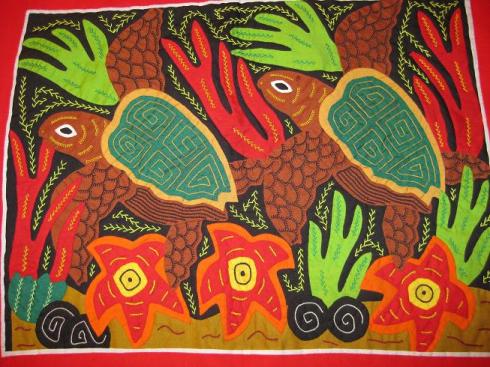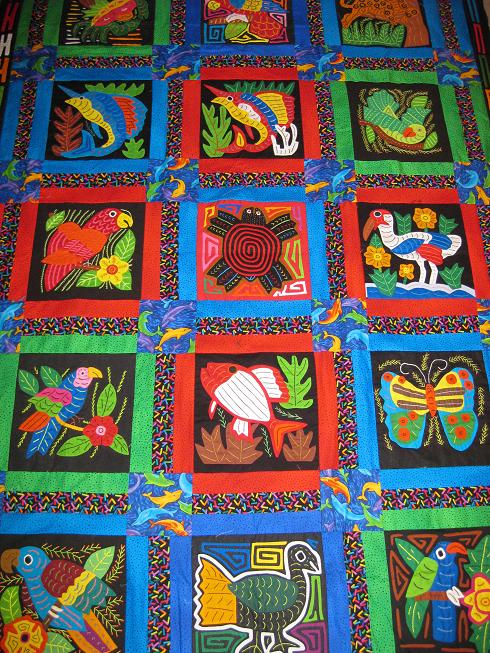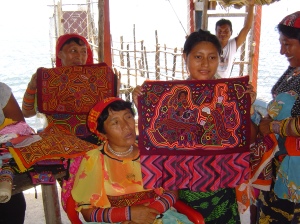What is a Mola?
There are many pieces of art in Panama that come from our aborigines, however the Mola is Panama’s most famous native artwork, and is one of the most recognized all over the world.
The word “Mola” is Morra in the Kuna Language (Dulegaya) which means the outfit of the female Kuna “Blouse” and it has a deep relationship with nature. The colors of those arts originate from their principal colors: the red, the black and orange.
These pieces are a true work of art and are highly desirable by many collectors.
The origin of the Mola
In the beginning the Kuna women wore animal skins decorated with feathers (Heron, pelican, parrot, macaw, etc.). When Ibeorgun arrived, he saw them wearing animal skins, and he taught them how to make clothing out of the Ikor tree. And there are comments that affirm that these art pieces were made of leaves and thread from the palm trees, needles were made from Sinyu (a tree with long thorns) and the Molas began to be sewn for the first time.
According to the first descriptions made by Andagoya, in 1514 the Kuna women painted their skin (bodies) with geometric designs. They used dyes extracted from vegetable fibres, especially red, blue and yellow.
In the middle of the 1600s the women worn mid-length skirts woven with natural fibres, multiple necklaces that partially hid their breasts, and rings in their noses. In the 1700s paintings began to appear on the blouses worn by the Kuna Women; in the 1800s they were wearing skirts, blue baftas (blouses), head coverings, gold nose rings, coin necklaces, and earrings; and during the early 1900s they were wearing the long chemise blouses with a large yoke made with a Mola, whilst others had a border in the bottom of the blouse, short sleeves made of plain or print fabric and a wraparound skirt of printed fabric.
Kuna Folklore: There were two important mythological figures that brought the traditional arts to the Kuna womens’ female ancestors, “Kikadiryai” who taught them how to make long dresses, weave hammocks and make pottery, told them the names of the Molas. The second mythological figure “Nagagiriyai” (Nele or Healer), discovered designs in her dreams, including the names of them, taught these designs to the women.
In the late nineteenth century, the women started to transfer body painting designs onto hand-woven cloth. This process eventually developed into the creation of designs that were cut and sewn onto imported fabrics.
With the Spanish Colonization the women had more access to modern tools and materials such as fabrics, scissors, and needles.
When the North Americans called “Merki” in Kuna came to San Blas to collect Sand for the construction of the Panama Canal, we started to see the first Molas with modern motifs.
San Blas Rainforest, Quilt – a beautiful quilt Rita made with Molitas sized 8 1/2″ x 8 1/2
Technique: Reverse Applique or Applique
The technique reverse applique is a little bit complicated, but Molas made this way are considered the best. The basic steps are: drawing the design, basting (called tacking in UK English), cutting, sewing.
The handwork is done in two panels, each panel has a similar design but is never exactly the same.
Mola panels are made by selecting 2 or more layers of fabric (up to 7 layers): Several rectangles are cut from a variety of colors, which will then be basted together, one layer at a time. One of the layers will serve as the base layer, and on the additional layers the design is sketched using a pencil starting with the top layer of cloth. The design is cut away, the edges are turned under and stitched, with each layer of cloth the same process will be repeated, allowing to reveal the colors beneath, until the final image is complete.
Keeping in mind that the base layer (bottom layer) will remain uncut, small geometric figures in applique/or embroidery stitching can be added to fill blank areas to embellish the panel. Most of the Molas are sewn with either a blind stitch or hem stitch.
Some of the more experienced womans can work without sketches.
Some Molas may have 2 layers, 3, 4 or more. The higher the number of layers naturally means a better quality textile piece. A Mola can take two weeks to six months or more, depending on the complexity of the design. Many hours of careful sewing are required to create an exquisite and fine Mola. Also there are a lot of techniques that can be used to elaborately embellish a mola.
Since Mola panels are worn they can show small signs of wear, this indicates that the Mola is authentic and not made solely and cheaply to be sold to tourists. I travel to Panama and then to the Islands to buy the blouses. The Molas I then carefully remove from the blouses, making sure that each Mola is in good condition with no fading, no stains, no tears, no dust, and no holes. I am very careful when I select my Molas. My promise is that you will receive the best Molas and the best quality that is out there.
This art has been handed down from grandmothers to mothers to daughters as very young girls for centuries. Young girls begin by sewing patterns cut for them by the women in the family. As they learn, they gradually sew more and more complex designs and are sometimes allowed to sew small sections of Molas the women are working on, progressing eventually to cutting and sewing their own blouses.
Many women today also sew panels expressly for sale, as well as products with Mola work, such as stuffed animals, Christmas ornaments, t-shirts, dresses, purses, pot holders and more. The production of these items can be influenced by tourists or Kuna perceptions of these people from other countries.
What is the ethos statement behind your mola art? (Who Benefits)
Through the sales of Molas the Kunas seek the means of financial security, a better education for their children, money for healthcare, etc. The Kunas live on small islands with limited economic opportunities.
A Kuna Ritual Mola
What is so special about Molas?
What make a Mola so special, is the mix of the striking designs, brilliant hues and meticulous stitching. A fabric crafter will be fascinated by the mixture of applique techniques (reverse, overlay, and inlay) and will recognize the hours of work that have gone into each piece.
A graphic designer will be fascinated by the variety of designs, from abstract to geometric, and from mazes to animals and plants. A home decorator will be inspired with the possibilities of delightful wall hangings, cushion covers. A quilter will be inspired by the unique work on each Mola, each technique is different (applique or reverse applique), the fine stitch on each piece, the mix of colors and how Molas can be incorporated into any quilting project.
Molas are one of the hottest collectible items and there are vintage Molas as well: the price will increase depending on the year that the Mola was made. They can be framed, made into pillows, quilts, bedspreads, wall hangings, sewn into blankets, your favorite purse or handbag, tote bags, placemats, jean jackets, vests, jeans, t-shirts, visors, cell phone holders, eye glass cases, book covers, chair covers, craft projects or used to decorate your children’s room.
This is an art of great beauty and mysterious origin.
A Kuna Woman showing a Traditional Mola
Who are the Kuna People?
The Kunas are one of the most important indigenous groups of Panama.
The residents of the Archipielago known as Kuna Yala, San Blas (Kuna Indians) are the most truly Native American, in the sense that they have retained their original lands, their traditions and their culture. The Kunas look similar from Island to Island, however each village is unique.
The Cuna or Kuna indios – the term “Kuna” is commonly used – have been settled in the San Blas Archipielago off the northeast coast of Panama since the nineteenth century. The Archipielago, known as Kuna Yala in their Native Language, is comprised of 365 islands, with approximately 50 being inhabited, the population estimated at 61,707. They are ruled by political, social and religious structures which are one of the most orderly and functional in the world. The Cuna term was introduced by the Spanish, we normally refer to the Kunas as the “indios or indians of San Blas” but they prefer to be called “Aboriginals”, sometimes you will hear the term “Tule or Tulemaya” meaning “people”. Their Native language “Dulegaya” meaning “people language” belongs to the Chibchans linguistic family, some of which is still spoken by native communities in Central America. These languages are different from Mayan, spoken in Mexico, Guatemala and South America.
What are the Kuna Rituals and what is so special about these Molas?
Kuna Ceremonies or Rituals are a big part of the Kuna Culture: music and songs are always present in every important moment in the life of the Kuna, from birth to death.
One of the most important Ceremonies is the Puberty. The Molas depicting Kuna Ritual or Ceremony are very important to the Kunas because they represent their Kuna cultural traditions, belief and ethnic identity.
These Molas are very desirable to any collector.
How did you became involved with Mola art? When did you learn about it?
I studied Economics in College as I always love anything that has to do with numbers, but for me there was always a very special place for art and history. My work experience here in the USA includes teaching computer programs, working in mortgages, selling real estate, however, there was always a love and passion for textiles and fabric. I always collected art from Panama, with which I would later start sewing.
In 2000 I finally listened to my artistic side and became interested in working with fabric, then later I started selling Molas online, the traditional textile art from my country. “Mola Art and Craft” was born with a dream of sharing the textile art of these remote islands located in Panama with everyone here in the USA and many other countries.
I was born and raised in Panama, so I have been around Molas most of my life.
Rita’s Mola pillows and wallhanging
Can you tell me about your latest products and the name of your collection?
First I want to tell you that my first collection was created in early 2008 and it was available for sale via my website in May 2008. I have been fortunate to sell all the purses through my website and some of them locally.
“BellaModa” is the name of my latest collection, including quilted purses, denim purses, pillows, pillow covers, aprons, children’s purses. Every handbag is individually made for you (one of a kind), and as is with every item I make, made with a lot of love, dedication and patience. Bella Moda is fine artwork, with cultural expressions and uniqueness in every way.
What inspired you to create this collection of denim and quilted purses, pillows, quilts and aprons?
I take inspiration from a lot of sources. My designs are obviously heavily influenced by flowers, birds, butterflies, turtles, but mostly by the beauty and color of the Molas, by my culture which is rich and colorful and by being genuinely inspired by what I see around me. By looking at today’s fashion and fabric trends, sometimes they can give me ideas, and then inspiration comes from all the different fabrics that I love working with and from the themes and colors on the contemporary Mola designs.
I have a passion for Kuna Molas, because of all the different colors, designs. I really like collecting many of them. I am the type of person who loves unique items and vibrant colors.
I enjoy creating items that people will be happy with and that my customers will love.
Which colors and themes do you use in this particular collection?
I have a passion and love for Mola art, and I try to use my flower themes in my private collection which are beautiful and include some geometric designs. I include colors like red, purple, pink, orange, and the reason why is because these are colors that really stand out, and they go well with black fabric; I also include any other color within the theme of the Mola. The Kunas use mostly primary colors. On the pillows I try to use birds, fish or perhaps geometric designs, and for these I like to work with fabrics in orange, blue, black and grey colors – the fabrics that I love have a silky feel and add a contemporary touch.
I will choose the colors according to the theme of each Mola or *Molita, I love including all kind of animals. On aprons, I will go for neutral colors and the Molas will be turtles, birds and any Molita will depict fruits, etc.
*A molita is a small version of a mola, which are also handmade. The molitas can be traditional or modern, however they are not incorporated in the Kuna blouses. But like the Mola, the Molitas are authentic, made by the Kuna Indians of Panama, for the purpose of making quilts, purses, make up bags, pot holders, children’s dresses, as a piece of art to be framed, and so on.
What kinds of fabric/material do you use and why?
I use fabrics that are 100% cotton with a soft feel, bindings, zippers, threads, fabrics that have a silky feel, little bit of shimmering and great quality fabric.
When quilting I try to incorporate fabrics from the collections of Robert Kauffman, Moda, Timeless, Batik. These are fabrics that go well with the Molas because they are so unique. I love designing my own quilts.
How long does it take to make a Mola? Is everything handstitched?
A Mola can take from 2 weeks to 6 months or more depending on the complexity of the design. I only incorporate Molas in my collection that are completely handmade.
At a Mola Exhibition – (Top) A young Kuna Woman with an unfinished “Modern” Mola; that she has designed, cut, basted or tacked the applique pieces on the foundation layer. (Bottom) A little Kuna Girl showing her mask.
Do you work alone or with others?
I #(working mother) work alone in my small studio at home. A typical day for me is uncomplicated…breakfast, lunch and after that I will probably think about the next project that comes to mind so I can put my abilities to work.
# Stephanie Faith wanted to add that Rita is also a mother to a young child!
How has your sales success been?
Well, I been very successful because my customers are being inspired not only by the collection of purses, but also from the quilts, pillows, aprons, wall hangings, etc.
Fish Mola
Had you had any famous customers?
Yes, designers, fibre artists, publishing companies.
I truly believe that people out there love all the items within my store. I recently made custom pillows for one of our customers in Australia.
Do you have any new projects in the pipeline?
Yes, I want to take Molas up to the next level, by creating new items that are a pleasure to my customers.
Do you have any tips on selling handmade items?
When selling handmade art the best things to do are to describe your items properly, let your customers know that what they are buying is unique and worthy. In my case, I personally try to make different projects with Molas to inspire others to be creative, and also I explain to customers how they can use the Molas, including the aftercare of them: how to wash or iron them. Do anything out there to promote your business.
What do you recommend someone should do if they want to learn Mola art? (books, classes, video, tutorials, etc).
Available for sale, we have a book about Molas and Kuna traditions with a lot of information about Molas. To order this book, please contact me. Along with the book you will also receive a pattern with instructions on how to make a simple Mola.
Instructions on how to make the pillows, quilts and purses are always available via my web site.
Ali Baba and The Forty Thieves. Morgiana pours hot oil into the jars in which the robbers are hidden!
Where can someone purchase your Mola Art?
On my website www.molaartandcraft.com which started with a dream of sharing this art from the remote Islands of San Blas through to a commitment of supporting the Kuna Indians of San Blas to maintain their history, traditions and culture. You can also contact me by email RitaSmith@Clearwire.net, and Cell. 937-422-4944, Tel.937-3534460 FaceBook: http://www.facebook.com/apps/application.php?id=149025033163
Copyright 2010 Rita Smith / edited by Stephanie Faith
















![sanblas4[1]](https://mistresscurvalicious.files.wordpress.com/2010/06/sanblas41.jpg?w=490)











Leave a comment